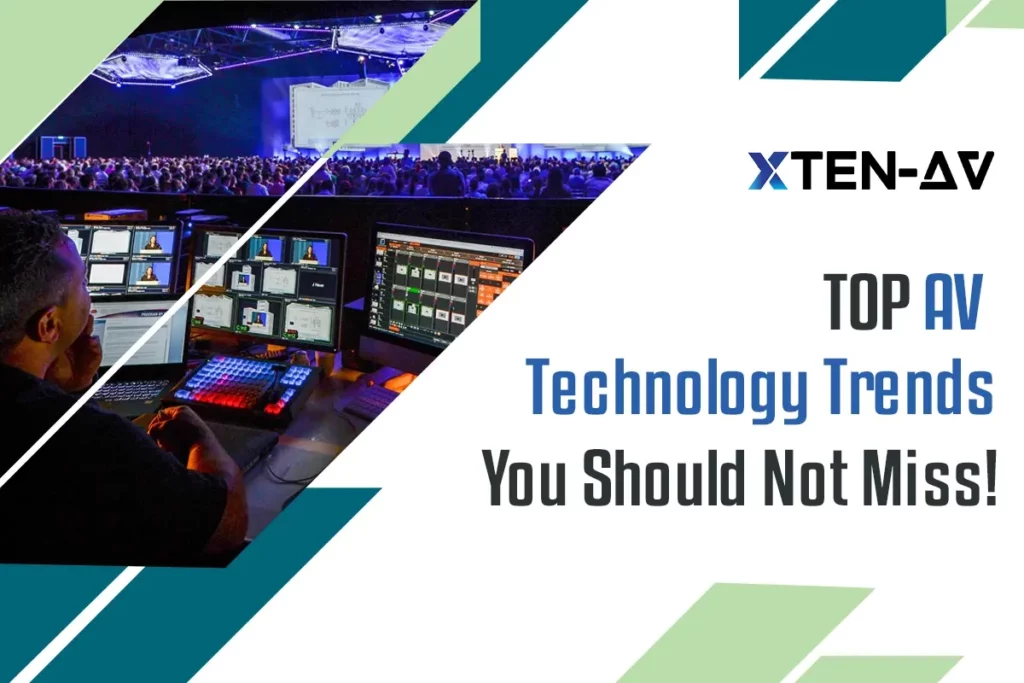TOP 6 Audio Visual AV Technology Trends You Cannot Miss!
As the audio visual industry is taking a rapid boom, it’s important to stay updated with the latest AV trends. This sector in itself is not that big, so when any trend follows, it is important that the AV companies are aware and take action to stay ahead of the curve.
Are you an audio visual company that’s functioning the old-school way? Well, it’s time to upgrade before you start losing out on clients. This blog will help you with the latest trends in the audio visual sector. We’ve also tried to give you examples in some sections to help you get a deeper understanding of the concept.
Growing Use of Collaboration Tools in the Audio Visual Industry!
Remote work is becoming mainstream nowadays; most companies have adopted a remote working culture since COVID-19. Now that the whole office is working remotely, there’s definitely a need for collaboration tools that help these organizations function better and smoothly. In recent years, 80% of audio visual companies have integrated collaboration software into their workflow. This is done to enhance communication and productivity all through one platform.
With a CAGR of 12.3%, the projected market growth from 2023 to 2033 is expected to be significantly higher than historical AV trends.
The necessity for effective and efficient project management across several teams, the emergence of virtual events, and the growing need for remote work solutions are the main causes of this notable increase in the usage of collaboration technologies.
Increased Use of Audio Video Technology in Hybrid Working Models
The adoption of audio video technology has seen a sharp increase in hybrid working models, blending remote and in-office work setups. Recent studies indicate that over 70% of organizations have implemented this AV trends to facilitate seamless communication between on-site and remote employees.
Audio visual technology enables features such as high-definition video conferencing, virtual meeting rooms, and interactive collaboration tools, enhancing productivity and teamwork among distributed teams. With hybrid work becoming the new trend, companies are increasingly relying on AV technologies to bridge the gap between remote and in-person interactions, driving innovation and efficiency in the modern workplace.
Introduction of AV Technologies in Healthcare & Education
The integration of AV technologies into healthcare and education sectors has witnessed a transformative AV trend impact in recent years. In healthcare, AV solutions have revolutionized patient care, training, and diagnostics. With the global telemedicine market expected to reach $155.1 billion by 2027, AV technologies facilitate remote consultations, enabling access to healthcare services irrespective of geographical barriers. Moreover, AV tools enhance medical education through immersive simulations and virtual training environments, improving learning outcomes and knowledge retention among healthcare professionals.
Similarly, in education, AV technologies are reshaping traditional learning environments. The global educational technology market is projected to surpass $285 billion by 2027, driven by the adoption of AV solutions for remote learning, interactive classrooms, and multimedia content delivery. These advancements not only enhance student engagement and collaboration but also cater to diverse learning styles, fostering inclusive education environments.
Incorporating AI in AV Design
Incorporating artificial intelligence into audiovisual design has revolutionized the way AV systems operate and interact with users. AI algorithms enable AV systems to analyze data, predict user preferences, and adapt in real time, enhancing user experience and system performance. Recent advancements in AI-driven AV design have led to innovations such as automated room configuration, intelligent content recognition, and personalized user interfaces.
According to a report by MarketsandMarkets, the global AI in AV market is expected to grow from $2.8 billion in 2021 to $11.2 billion by 2026, reflecting the increasing adoption of AI technologies in AV systems across various industries. These AI-infused audio video solutions not only improve efficiency and productivity but also pave the way for more intuitive and immersive user experiences, driving innovation in the AV industry.
Another Great Addition to AV Trends is AV-as-a-Service (AVAAS)
AV-as-a-Service is one of the most rapidly growing AV trends, offering companies a flexible and cost-effective way to access AV technology and services. The AV industry is projected to reach $66.02 Billion by the year 2029 with a CAGR of 24.45%, driven by the increasing demand for scalable solutions and the shift towards subscription-based models. AVaaS providers offer various services, including equipment rental, installation, maintenance, and support, allowing organizations to access AV solutions. This model enables businesses to adapt to changing needs and technologies more efficiently while reducing the burden of ownership and maintenance costs.
Introducing a cutting-edge tool is revolutionizing AV service provision. XTEN-AV is the only cloud-based software in the audio visual design industry. An innovative platform designed to streamline the entire AV design process, from concept to completion. We help audio visual companies store their data, optimize their workflows, improve project efficiency, and deliver exceptional AV space to their clients all in one place.
The Latest AV Trends is Virtual Reality Technology
One of the latest AV trends is virtual reality, not just in this sector but in most sectors. It has become a great addition to the AV industry as it helps companies let their client visualize better, and it gets easier to sell their services. With a simple combination of virtual and augmented reality, AV businesses have seen a boom like never before.
Through VR, the audio video industry has opened up many new possibilities. However, there is not much software available that can help AV designers create designs. XTEN-AV has recently launched X-VRSE, through which you can help your clients visualize what their space will look like after installations.
AV Design Mastery + Winning Proposals = 10x Productivity!
- Automatic Cable Labeling & Styling
- 100+ Free Proposal Templates
- Upload & Create Floor Plans
- 1.5M Products from 5200 Brands
- AI-powered ‘Search Sense'
- Legally Binding Digital Signatures
Conclusion
It’s certain that the AV industry is undergoing a transformative evolution that is totally driven by the AV trends we’ve shared above. From AI-powered automation to immersive experiences and collaborative solutions, the possibilities for enhancing communication, education, and business operations are limitless.
By embracing these trends and leveraging cutting-edge AV technologies, organizations can unlock new opportunities for growth, efficiency, and creativity. As we look ahead, let’s continue to embrace the spirit of innovation, adaptability, and collaboration that defines the dynamic world of audiovisual technology.
Frequently Asked Questions
The current AV trends include the use of AI for AV design, VR solutions, inclusion of AV technology in the healthcare and education sector. There are many more upcoming trends in the industry. However, there’s still a long way to go for the audio visual sector. According to most research, VR is the biggest leap this sector has taken yet.
The simple answer is automation! There’s more to it, but the major benefits of AI are automation, personalized user experience, predictive maintenance, and improved analytics. AI-integrated software helps AV integrators simplify their tasks by automatically designing according to their preferences and streamlining workflow.
As the corporate sector is more towards remote working, collaboration is a problem faced by most organizations. To conquer this they can incorporate AV into their business processes. Technologies like interactive displays, whiteboards, cloud based AV management software.
AV trends are supporting education by offering remote learning opportunities. This can be done through Video conferencing tools and online collaboration platforms. VRs can play a big role in enhancing education by enabling personalized learning experiences.


